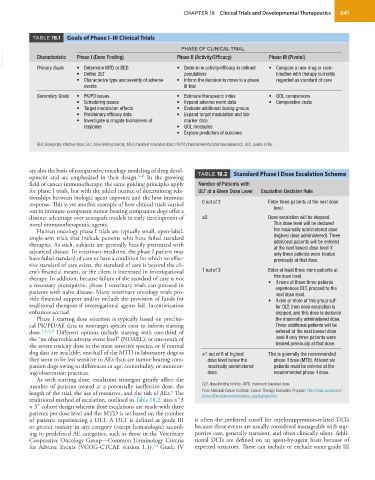Page 363 - Withrow and MacEwen's Small Animal Clinical Oncology, 6th Edition
P. 363
CHAPTER 18 Clinical Trials and Developmental Therapeutics 341
TABLE 18.1 Goals of Phase I–III Clinical Trials
PHASE OF CLINICAL TRIAL
VetBooks.ir Characteristic Phase I (Dose Finding) Phase II (Activity/Efficacy) Phase III (Pivotal)
Primary Goals
• Determine MTD or BED
populations
bination with therapy currently
• Define DLT • Determine activity/efficacy in defined • Compare a new drug or com-
• Characterize type and severity of adverse • Inform the decision to move to a phase regarded as standard of care
events III trial
Secondary Goals • PK/PD issues • Estimate therapeutic index • QOL comparisons
• Scheduling issues • Expand adverse event data • Comparative costs
• Target modulation effects • Evaluate additional dosing groups
• Preliminary efficacy data • Expand target modulation and bio-
• Investigate surrogate biomarkers of marker data
response • QOL measures
• Explore predictors of outcome
BED, Biologically effective dose; DLT, dose-limiting toxicity; MTD, maximum tolerated dose; PK/PD, pharmacokinetic/pharmacodynamics; QOL, quality of life.
are also the basis of comparative oncology modeling of drug devel-
opment and are emphasized in their design. 6–8 In the growing TABLE 18.2 Standard Phase I Dose Escalation Scheme
field of cancer immunotherapy, the same guiding principles apply Number of Patients with
for phase I trials, but with the added nuance of determining rela- DLT at a Given Dose Level Escalation Decision Rule
tionships between biologic agent exposure and the host immune
response. This is yet another example of how clinical trials carried 0 out of 3 Enter three patients at the next dose
out in immune-competent tumor-bearing companion dogs offer a level.
distinct advantage over xenograft models in early development of ≥2 Dose escalation will be stopped.
novel immunotherapeutic agents. This dose level will be declared
Human oncology phase I trials are typically small, open-label, the maximally administered dose
single-arm trials that include patients who have failed standard (highest dose administered). Three
therapies. As such, subjects are generally heavily pretreated with additional patients will be entered
advanced disease. In veterinary medicine, the phase I patient may at the next lowest dose level if
only three patients were treated
have failed standard of care or have a condition for which no effec- previously at that dose.
tive standard of care exists, the standard of care is beyond the cli-
ent’s financial means, or the client is interested in investigational 1 out of 3 Enter at least three more patients at
therapy. In addition, because failure of the standard of care is not this dose level.
a necessary prerequisite, phase I veterinary trials can proceed in • If none of these three patients
patients with naïve disease. Many veterinary oncology trials pro- experiences DLT, proceed to the
next dose level.
vide financial support and/or include the provision of funds for • If one or more of this group suf-
traditional therapies if investigational agents fail. Incentivization fer DLT, then dose escalation is
enhances accrual. stopped, and this dose is declared
Phase I starting dose selection is typically based on preclini- the maximally administered dose.
cal PK/PD/AE data in nontarget species exist to inform starting Three additional patients will be
dose. 1,3–5,9 Different options include starting with one-third of entered at the next lowest dose
the “no observable adverse event level” (NOAEL), or one-tenth of level if only three patients were
the severe toxicity dose in the most sensitive species, or if normal treated previously at that dose.
dog data are available, one-half of the MTD in laboratory dogs as ≤1 out of 6 at highest This is generally the recommended
they seem to be less sensitive to AEs than are tumor-bearing com- dose level below the phase II dose (MTD). At least six
panion dogs owing to differences in age, comorbidity, or monitor- maximally administered patients must be entered at the
ing/observation practices. dose recommended phase II dose.
As with starting dose, escalation strategies greatly affect the
number of patients treated at a potentially ineffective dose, the DLT, dose-limiting toxicity; MTD, maximum tolerated dose.
9
length of the trial, the use of resources, and the risk of AEs. The From National Cancer Institute: Cancer Therapy Evaluation Program: http://ctep.cancer.gov/
traditional method of escalation, outlined in Table 18.2, uses a “3 protocolDevelopment/templates_applications.htm.
× 3” cohort design wherein dose escalations are made with three
patients per dose level and the MTD is set based on the number
of patients experiencing a DLT. A DLT is defined as grade III is often the preferred cutoff for myelosuppression-related DLTs
or greater toxicity in any category (except hematologic) accord- because these events are usually considered manageable with sup-
ing to predefined AE categories, such as those in the Veterinary portive care, generally transient, and often clinically silent. Addi-
Cooperative Oncology Group—Common Terminology Criteria tional DLTs are defined on an agent-by-agent basis because of
for Adverse Events (VCOG-CTCAE version 1.1). Grade IV expected toxicities. These can include or exclude some grade III
10

